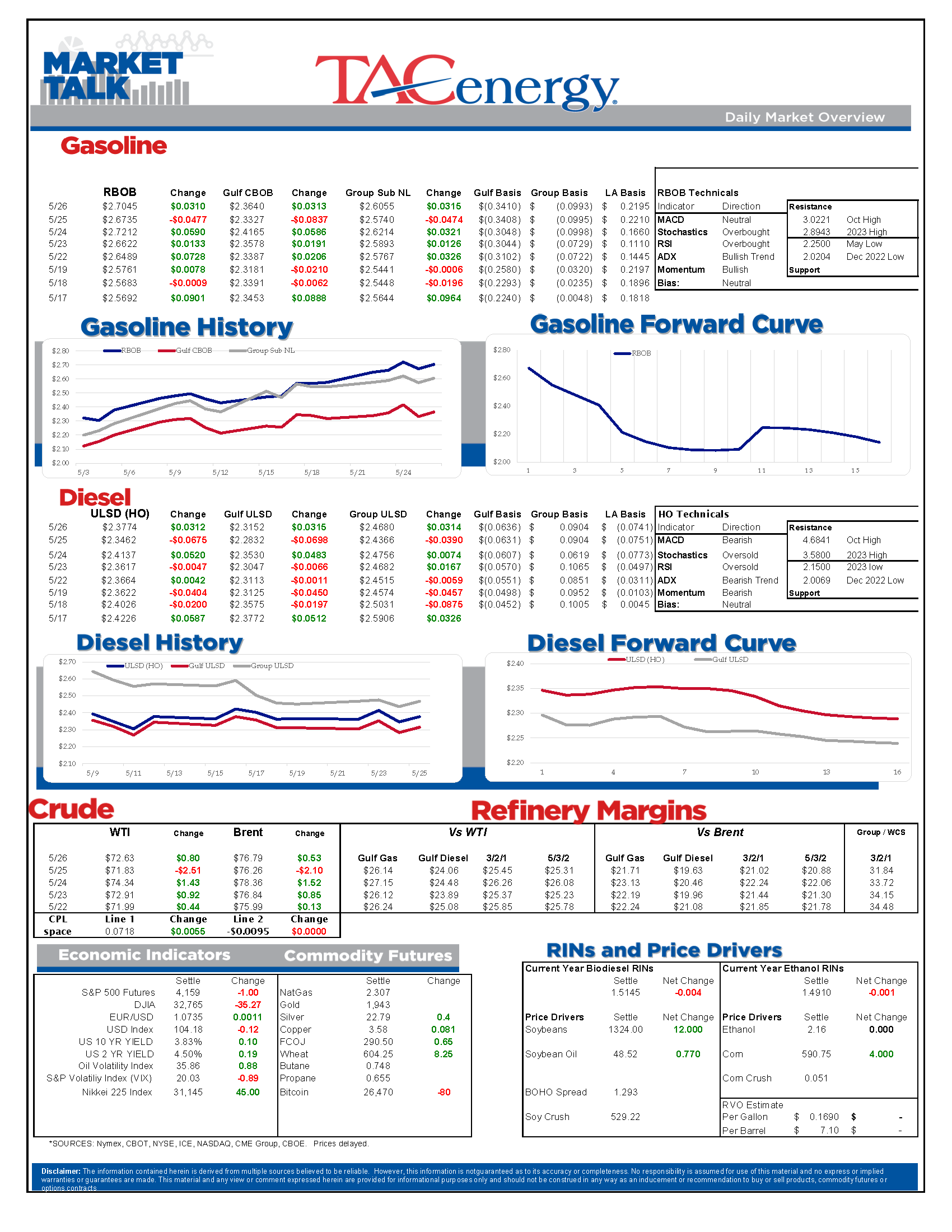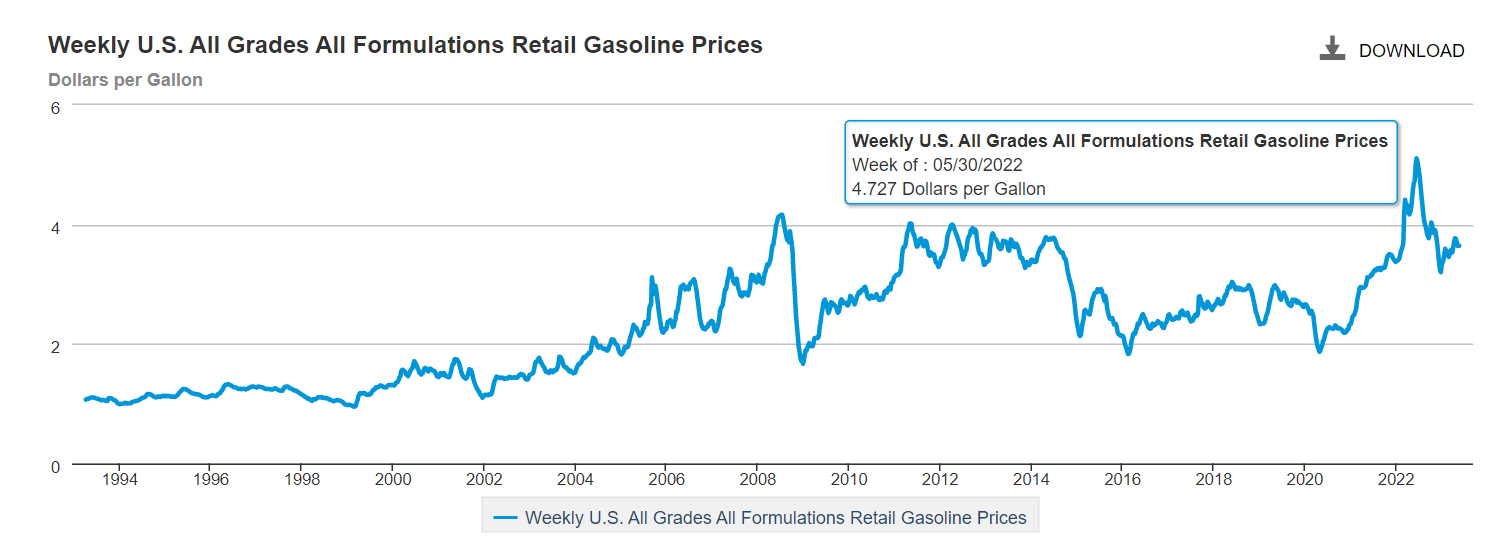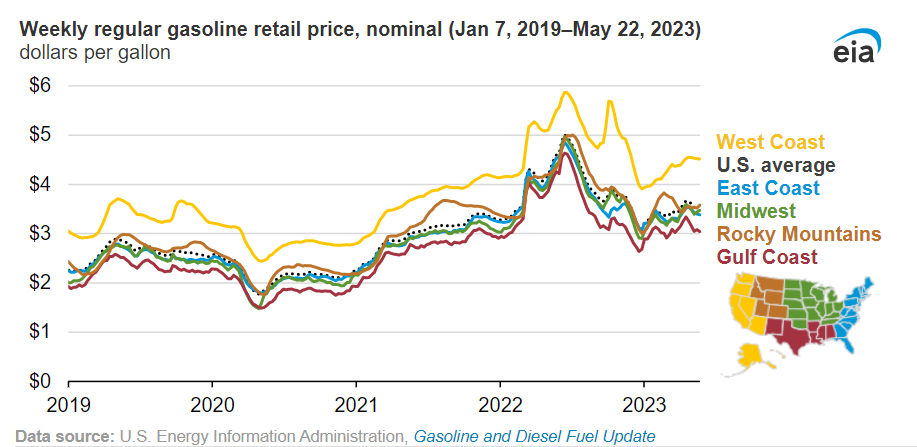Memorial Day Gasoline And Diesel Prices Down From Last Years Record Setting Levels

Energy prices are ticking modestly higher after a big Thursday sell-off wiped out most of the gains made earlier in the week as a pair of disagreements continues to keep traders guessing.
Drivers heading out for Memorial Day weekend are enjoying retail gasoline prices that are more than $1.20/gallon less than last year’s record setting levels on average, thanks to the world’s supply network adjusting to the Russian supply shock. The year-on-year price drop is even more dramatic for diesel prices that are down $1.65/gallon on average, thanks to the “freight recession” pushing demand sharply lower.
Deal or no deal? The political theatre continues in Washington with both sides preparing to declare victory in the debt debate, while dragging out the negotiations to the last minute in an effort to boost ratings.
Saudi Arabia and Russia are sending mixed messages on oil production quotas a week before the next OPEC & Friends meeting. This isn’t exactly new as Russia has been violating its official quotas for some time (which isn’t too surprising considering these are the same people that invaded Ukraine twice in the past decade) but the big question is whether or not the Saudi’s decide to teach them a lesson and turn this into another price war as they did in 2014 and 2020.
NOAA predicted a “near normal” hurricane season in the Atlantic this year, with an El Nino pattern developing which will act as a counterbalance to the high-water temps in the Atlantic to some degree. The forecast does warn that conditions for tropical waves forming off of the coast of Africa are favorable, which is where several of the biggest storms of all time have formed. The outlook ends with its annual warning that despite the prediction for less activity this year than we’ve seen the past 3 years, it still only takes 1 storm to cause major disruptions.
Pemex auditors are apparently admitting that the new 340,000 barrel/day refinery that had a grand opening last year was still not ready to produce refined products, and that the most recent target of July 2023 “was not feasible”.
The Dallas FED published a look at the rapid growth at the busiest energy export port in the US this week, and it’s not the one you think it is.
Click here to download a PDF of today's TACenergy Market Talk.
News & Views
View All
Energy Futures Are Caught Up In Headline Tug-O-War This Morning
Energy futures are caught up in headline tug-o-war this morning with Canadian oil production concerns and a positive US GDP report trying to push prices higher while sinking Chinese demand worries and Gaza ceasefire hopes are applying downward pressure. The latter two seem to be favored more so far this morning with WTI and Brent crude oil futures down ~45 cents per barrel, while gasoline and diesel prices are down about half a cent and two cents, respectively.
No news is good news? Chicago gasoline prices dropped nearly 30 cents yesterday, despite there not being any update on Exxon’s Joliet refinery after further damage was discovered Wednesday. Its tough to say if traders have realized the supply situation isn’t as bad as originally thought or if this historically volatile market is just being itself (aka ‘Chicago being Chicago’).
The rain isn’t letting up along the Texas Gulf Coast today and is forecasted to carry on through the weekend. While much of the greater Houston area is under flood watch, only two refineries are within the (more serious) flood warning area: Marathon’s Galveston Bay and Valero’s Texas City refineries. However, notification that more work is needed at Phillip’s 66 Borger refinery (up in the panhandle) is the only filing we’ve seen come through the TECQ, so far.
Premiums over the tariff on Colonial’s Line 1 (aka linespace value) returned to zero yesterday, and actually traded in the negatives, after its extended run of positive values atypical of this time of year. Line 1’s counterpart, Line 2, which carries distillates from Houston to Greensboro NC, has traded at a discount so far this year, due to the healthy, if not over-, supply of diesel along the eastern seaboard.
Click here to download a PDF of today's TACenergy Market Talk.

WTI And Brent Crude Oil Futures Are Trading ~$1.50 Per Barrel Lower In Pre-Market Trading
The across-the-board drawdown in national energy stockpiles, as reported by the Department of Energy yesterday, stoked bullish sentiment Wednesday and prompt month gasoline, diesel, and crude oil futures published gains on the day. Those gains are being given back this morning.
The surprise rate cut by the People’s Bank of China is being blamed for the selling we are seeing in energy markets this morning. While the interest rate drop in both short- and medium-term loans won’t likely affect energy prices outright, the concern lies in the overall economic health of the world’s second largest economy and crude oil consumer. Prompt month WTI and Brent crude oil futures are trading ~$1.50 per barrel lower in pre-market trading, gasoline and diesel are following suit, shaving off .0400-.0450 per gallon.
Chicagoland RBOB has maintained its 60-cent premium over New York prices through this morning and shows no sign of coming down any time soon. Quite the opposite in fact: the storm damage, which knocked Exxon Mobil’s Joliet refinery offline on 7/15, seems to be more extensive than initially thought, potentially extending the repair time and pushing back the expected return date.
There are three main refineries that feed the Chicago market, the impact from one of them shutting down abruptly can be seen in the charts derived from aforementioned data published by the DOE. Refinery throughput in PADD 2 dropped 183,000 barrels per day, driving gasoline stockpiles in the area down to a new 5-year seasonal low.
While it seems all is quiet on the Atlantic front (for now), America’s Refineryland is forecasted to receive non-stop rain and thunderstorms for the next four days. While it may not be as dramatic as a hurricane, flooding and power outages can shut down refineries, and cities for that matter, all the same, as we learned from Beryl.





